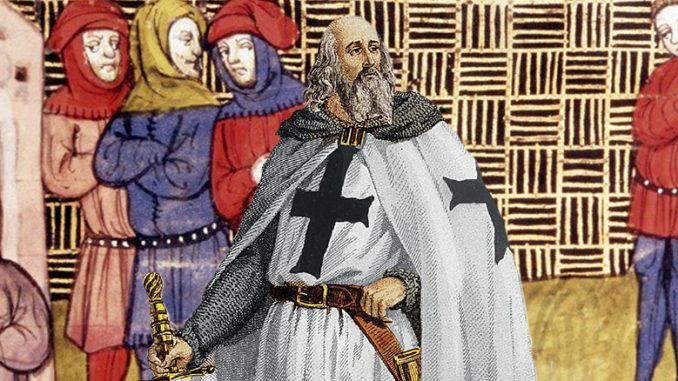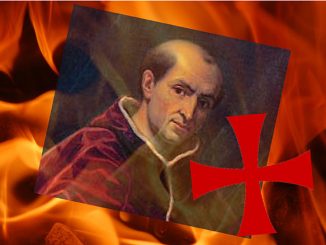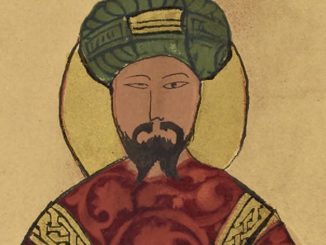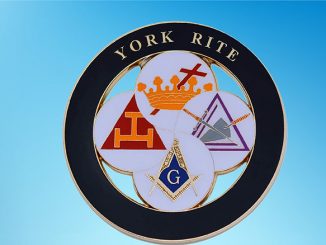
The following article on Jacques de Molay was originally published in the June 1916 issue of The Builder.
Publisher’s Note: Many of the writings of early Masonic historians took considerable liberties with Templar History, connecting their lineage to the Freemasons. As such, we present this information as a record of what was considered historic in the past. The reader should take some caution as to the authenticity.
by Alfred Lawrence
Jacques Bernard de Molai (or de Molay), a native of Burgundy, was born in the year 1243, and his life and times are of deep interest to Masons, and especially to Knights Templar, owing to the fact of his being the last Grand Master of the Order of Templars, together with his heroic martyrdom for the cause to which he had devoted practically his entire life. He was the youngest brother of one of the most distinguished houses of the “Compte” of Burgundy, his elder brother having a large property and a higher position.
Entering the Order in 1265, at the age of 22 years, he had passed through all the degrees and became Grand Prior (or Preceptor) of England. His devotion and service resulted in his acquiring an enviable reputation throughout the Templar world of that strenuous period.
A man of true merit, of undaunted bravery, highly intellectual, of amiable disposition and pure morals, with a character beyond reproach, meriting and receiving the favor of his King, he was a welcome guest at the Court of France. In 1297 his treacherous sovereign selected him for the distinguished honor of holding his (the King’s) fourth son, M. Robert, at the baptismal font. All this time Philip the Fair, while pretending friendship for de Molai and the Order, with avaricious eyes looked longingly at the rich possessions of the Templars, and was secretly plotting their destruction. Ignorant of the hatred of the King, the lords of his Court held de Molai in such high esteem that they aided in his election as Grand Master in 1298. In 1302 de Molai, as the Head of this powerful Order, made the last effort–a result of the seven Crusades that had swept Europe for several centuries–to recover Palestine from the Moslem hordes, but he and his faithful followers suffered defeat at the hands of the Sultan of Egypt, with a loss of 120 Knights; and this ended their endeavors to recover the Holy Land. After that the activities of this powerful Order, as a military organization, ceased.
By many grants from time to time the Templars had become possessed of large estates and were very rich and prosperous. The cupidity of the clergy, the need of money by their avaricious King, and the decadence of the Templars as a military organization, were the principal factors leading to their downfall.
The first Grand Master of this famous Order of Templars was Hugho de Payens, elected in 1118, followed by Robert de Craon, 1136; Everard des Barres, 1146; Bernard deTremelay, 1151; Bertrand de Blanquefort, 1154; Philip of Naplous, 1167; Odo de St. Amand, 1170; Arnold de Torroge, 1180; Gerard de Ridefort, 1185; Brother Walter, 1189; Robert de Sable, 1191; Gilbert Horal, 1195; Philip Duplesseis, 1201; William de Charters, (date of election unknown) who died in 1218; Peter de Montague, 1218; Herman de Perigord, 1236; William de Sonnac, 1245; Reginald de Vichier, 1152; Thomas Berard, 1256; William de Beaujeu, 1273; Theobald de Gaudini, 1291; and finally in 1297 Jacques de Molay, Preceptor of England, was elected Grand Master by a general Chapter of the Order.
It is interesting to note in this connection that King John of England frequently resided at the Temple London, and it was there that he resigned England Ireland ” to his lord Pope Innocent the Third,” and signed that epoch-making document “Magna Charta.” This historic building, which became Crown property upon the dissolution of the Order in 1313, afterwards came into possession of the Knights of St. John, who in 1346 leased it to the students of common law, and it has served continuously since then as a law school and today houses the inns of court–societies for the study of law and possessing exclusively the privilege of calling to the bar – four in number, the Inner and Middle Temple, Lincoln’s Inn and Gray’s Inn.
The events that led up to the tragic death of de Molai and the dissipation of Order and confiscation their estates, was the avarice of Philip IV, called Phillip the Fair, the sore financial straits in which the French monarchy found itself coupled with the cupidity of the clergy and the vacillating character of Pope Clement V. Philip pretended to be anxious for a new crusade, and at his instigation Clement V called the Grand Masters of the Templars and Knights of John to Europe. De Molai, as a true soldier of the cross, answered this summons and returned to France in the fall of 1306, accompanied by a chosen band of distinguished Knights of the Order. He repaired to Portiers in 1307 to render allegiance to the Pope, and at that time nothing was said about investigating the affairs of the Order.
Shortly thereafter Philip appeared before Clement and preferred charges demanding the dissolution of the Order. As this was the beginning of French or Avignon Papacy, the Pope was largely under the influence of Philip and was finally induced to order this investigation. Instead of awaiting this papal investigation, however, the King immediately procured the arrest of every Templar in France, and on October 13, 1307, de Molai was seized in the house of the Temple and taken before special commissioners of the Inquisition.
Although the Pope was indignant at this presumption the part of Philip, and suspended the power of the Inquisition, yet the King’s influence was so great that he finally compelled the Pope to take part in the action. De Molai was thereupon examined by a Papal commission, and under torture confessed the truth of some of the charges. On March 11, 1314, he was condemned to perpetual imprisonment. He immediately retracted all he had said while under torture, and this so infuriated the King that the latter ordered him forcibly seized and burnt at the stake the same evening. This occurred in front of Notre Dame, Paris, and as the flames mounted up about his body and were fast consuming his flesh, after protesting the innocence of the Order, he called aloud to the surrounding crowd, “You who behold us perishing in the flames shall decide our innocence ! I summon Pope Clement V to appear in forty days and Philip the Fair in twelve months before the just and terrible throne of the everliving God, to render an account of the blood which they have unjustly and wickedly shed.”
With him perished Guy, the Grand Preceptor; Hugo de Paralt (or Peraldes), the Visitor General; and Theodore Bazile de Merioncourt. Retribution followed swiftly; the King Philip IV dying four weeks later embittered by misfortune and deserted by his nobles. Pope Clement V, after a painful and lingering illness, died one year and a month after the death of these martyred Templars; and it is recorded that all those others foremost in persecuting the Templars came to an untimely and miserable death.
King Philip had plotted to invest one of his sons with the title of King of Hierusalem, (Jerusalem), and hoped to procure of Pope Clement V the large revenues of the Order by this dastardly act. What actually occurred was the confiscation of the possessions of the Templars which were divided among various Orders, many of the surviving Knights of the Order languished in dungeons, and the remainder were compelled to leave their homes, discard their Templar garb and go forth penniless into the world.
Tradition tells us that the surviving Templars became divided into four parties: (1) Templars in Portugal and Italy, known since as Knights of the “Order of Christ”; (2) those who accepted Peter d’Aumont- as the successor of de Molai; (3) those who asserted that John Marc Larmenius was his successor; and (4) those who refused to accept either d’Aumont or Larmenius. Modern Templarism is supposed to be derived from the fourth class, although there are no historically authentic documents to prove this contention.
Addison, on the contrary, claims that de Molai appointed as his successor John Marc Larmenius, of Jerusalem, and that from him a regular uninterrupted line of Grand Masters succeeded, and that the Charter of transmission with the signatures of the various chiefs of the Temple, together with the ancient statutes of the Order, the rituals, records, seals, standards, and the early memorials of the Templars, are preserved at Paris. As Grand Masters were elected, and not appointed, such a succession to say the least from de Molai could not be regular. This with many other points in the history of various Orders that flourished and were powerful factors for good during this troubled period, together with the early history of Knights Templarism as it exists today, are fruitful fields for Masonic research, which it is to be hoped some member of the National Masonic Research Society can take up at an early date and prosecute to a successful issue.
The life and tragic death of Jacques de Molay should be an inspiration to every Mason zealously to work for the advancement and uplifting of our beloved fraternity, and so usefully conduct his own life that he can in the evening of his own earthly existence, lay aside his working tools and fall asleep to awaken in that “Celestial Temple,” and greet this perfect Knight whose enfranchised spirit soared aloft these six centuries agone.
About Us
We hope you enjoyed this article on Jacques de Molay.
TemplarHistory.com was started in the fall of 1997 by Stephen Dafoe, a Canadian author who has written several books on the Templars and related subjects.
Read more from our Templar History Archives – Templar History



